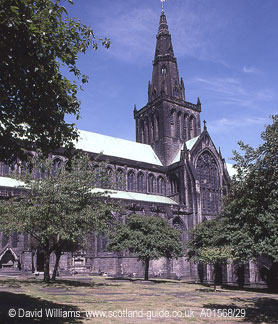The history of this site goes back to the fifth century when the missionary St Ninian consecrated a graveyard here.
In the sixth century a priest, who later became St Mungo, buried a holy man by the name of Fergus here. St Mungo later became Glasgow`s bishop, founded a religious community and built a church in which he was himself buried in c.612. His shrine later became a place of pilgrimage and much later he was `elevated` to the role of patron saint of Glasgow and his deeds became celebrated on the city`s coat of arms. The earliest stone church on this site was erected in the eleventh century, to be succeeded by a new building consecrated in 1197. The thirteenth century saw large extensions (the Quire, the Lower Church and the two Chapter Houses) which essentially form the core of the building as it is today. Two large towers were later erected at the west end but these were demolished in the 1840s.
With the Cathedral, the Bishop`s Castle and all the ancillary buildings,
this seat of Church power wielded much influence up to the sixteenth-century`s
Protestant Reformation. After that, the cathedral was divided in order
to accommodate three smaller churches and the power and wealth of the
Church waned considerably. Today it is Scotland`s most important thirteenth-century
building and it is the city`s most impressive structure, but one which
has far less general significance to the city than it had in previous
centuries.
Further details about the building can be found in "The Glasgow Guide".
This article is based on the guidebook "The Glasgow Guide".

Glasgow Cathedral from the south.
An old graveyard surrounds the building and many of the oldest gravestones lie flat in the grass.